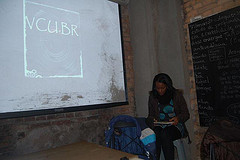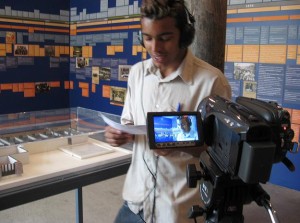The results: a model of community media entrepreneurship
The Results: The ‘Collective’ Model of Community Media Entrepreneurship
The bottom line – did the VCU.br project succeed? Yes, in the sense that the project derived a model for a collective that will keep people working in media. This is a model that can be used by other organizations.
But what did not succeed exactly was the model of ‘one person, one business’, i.e. the community media entrepreneurs working independently on their own and getting their own clients. Video Volunteers is therefore recommending a collective model as the right model for Brazil nonprofit media NGOs. Video Volunteers hopes the findings of this project will be of use to other NGOs.
 What follows on this page is a description of the market for videos produced by slumdwellers in Sáo Paolo, the detailed financial results of VCU.br’s first year, a description of the two financial models explored – working as a collective, and working independently – and Video Volunteers’ recommendations for other Brazilian NGOs (and possibly ones in other countries) to integrate livelihoods into their program. Finally, the report ends by saying how Video Volunteers’ findings in Brazil are similar and different to those from Video Volunteers’ India program.
What follows on this page is a description of the market for videos produced by slumdwellers in Sáo Paolo, the detailed financial results of VCU.br’s first year, a description of the two financial models explored – working as a collective, and working independently – and Video Volunteers’ recommendations for other Brazilian NGOs (and possibly ones in other countries) to integrate livelihoods into their program. Finally, the report ends by saying how Video Volunteers’ findings in Brazil are similar and different to those from Video Volunteers’ India program.
The Market: the price point for video production in Sáo Paolo
The trainees conducted a market research in Sáo Paolo to understand who their clients could be, what kinds of videos they could make, and how much they could charge, based on what the ‘going rate’ is currently for each type of video.
| Type of production | The Going Rate in Sáo Paolo |
|
|
|
| Marriage Videography | R$700.00-R$1400 [USD$400-820] |
|
|
|
| Corporate function videography | R$800-R$1100 [USD$ 470-650] |
|
|
|
| Private party videography | R$500 – R$900 [USD$ 300-550] |
|
|
|
| NGO videography | R$300 –R$500 [USD$ 176 – USD 294] |
|
|
|
| Miscellaneous video clip production | Starting from R$500 [USD$ 294] |
|
|
|
In any calculation of how much a video producer can earn, the first step is to figure out how much they need to earn. In earlier exercises, each producer said they needed to earn R$790 [USD 464] per month to do this work full time. Next, one must estimate how many projects of each category a producer can get contracts for, and how many they will need to secure each year.
A Replicable Approach: The Community Media Collective
The VCU.br community media entrepreneurs decided to constitute a new media collective called Colectivo Caçamba. Here’s how it works: they are bearing 100% of their travel and salary costs.The collective members have access, free of cost, to Casa Das Caldeiras (host NGO) computers. Overheads and travel are kept low because the producers only come to the centre twice a week. Casa Das Caldeiras bears the costs of the supervisors time – about 1-2 days a week – and for incidentals like electricity.

So what are the results? In the first six months after the end of the formal training, they earned R$10,070 [USD 5915] from six paying projects:
| Production Job | The Collective’s Pay |
|
|
|
| Video for a promotional event for Sáo Paolo restaurants (Mica Restaurant Week) | Collective paid R$2,000.00 [USD 1,174] |
|
|
|
| Recording of a show at a local theatre (Teatro Corinthians) | Collective paid R$1,000.00 [USD 587] |
|
|
|
| Recording of a show performed by a local theatre troupe (Beyond Life) | Collective paid R$1000 [USD 587] |
|
|
|
| Recording of rehearsals and performances of a local theater group (Tablado de Arruar) | Collective paid R$6,500.00 [USD 3817] for filming over four months |
|
|
|
| Filming of monthly black culture fair at Casa das Caldeiras | Collective paid R$3,500.00 [USD 2055] for filming over six months. |
|
|
|
| Coverage of a six day electronic language festival (FILE) held in Sáo Paolo | Collective paid R$3200 [USD 1880] |
|
|
|
This income was divided between the collective members to contribute towards their living costs.
There are currently four members in the collective, who spend about 25% of their time working on collective projects, and the rest is filled with studying and undertaking other work (e.g. one collective member does odd jobs and works part time as a driver).
- Each collective member has earned approximately R$420 [USD 247] per month for working approximately 25% of the time.
- This covers 53% of their monthly expected earnings.
- If collective members were to work 100% of the time on collective projects they could earn up to R$1680 [USD$ 1000], which is more than double their desired monthly income.
With this in mind, the collective presents a financially viable model. In order to replicate this model, an NGO will need to provide the start up and training costs for a collective, which thankfully, all media training groups in Brazil do, since they all have facilities, equipment and staff already. Thus, the potential to role out this model on a larger scale is quite high.
For a discussion about why the entrepreneurs are not generating their full potential income we need to ask, does the fellow’s commitment to social issues compromise their ability to make money? Are they learning less because they choose to subsidize social projects – either film projects or personal voluntary work – that lowers their income?
One Person, One Business: The Independent Model
This model is undoubtedly more challenging than the collective model outlined above. The VCU.br Fellows did not choose to go this route, because it is more challenging financially but also for personal reasons, in that is lonelier and perhaps requires more ‘drive.’
In this model each person needs a camera, a computer, travel and overheads to set up his or her own home business.
- If equipment (camera and computer) is R$2,050 [USD 1200] and they take out a bank loan charging 20% interest to cover this initial investment then they need R$205 [USD 120] per month to pay back this debt.
- Their desired monthly income has already been calculated to be R$790 [USD 464]. Add to this R$500 [USD 294] for initial overheads and R$50 [USD 30] per month for travel.
- The total monthly revenue that needs to be generated to cover all this is R$1056 [USD 620].
Based on the financial results of Coletiva Caçamba, which showed that each youth, if they worked full time, could earn around R$1600 per month, it is clear that it is absolutely possible to generate this amount.
 It is also hugely challenging—the entrepreneurs need to market themselves effectively as individually and can’t share their costs with others. They will have to do a lot of networking and meetings to get enough projects to sustain themselves. Working independently is always a greater challenge and far riskier.
It is also hugely challenging—the entrepreneurs need to market themselves effectively as individually and can’t share their costs with others. They will have to do a lot of networking and meetings to get enough projects to sustain themselves. Working independently is always a greater challenge and far riskier.
Video Volunteers found that the “one person, one business” model is more challenging in Brazil than in India, where the IndiaUnheard program is quite close to a “one person, one business” model. The difference is that Video Volunteers’ IU program works on a larger scale. Also, the rural poor in India arguably have fewer job opportunities than favela youth in Brazil and so they are willing to work hard at video full-time.
Recommendations to other media NGOs
Video Volunteers believes that many media training organizations in the developing world could see approximately 50% of their graduates continuing in the field of media. To do this, they would need to start providing basic business training to their trainees from day one and encourage them to start a media collective like Caçamba.
Video Volunteers’ rough calculation was that less than 5% of graduates of NGO media programs in Brazil are currently working in media. It is clear that one way to permanently alter the mainstream media landscape, in a country like Brazil (or even the US) where numerous young people are learning video, is to ensure that everyone is able to keep using their skills. VCU.br has shown this is possible.

